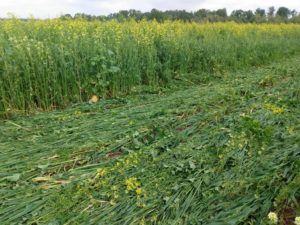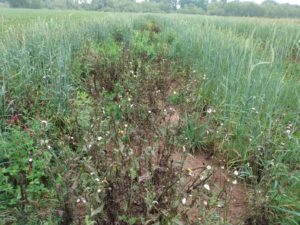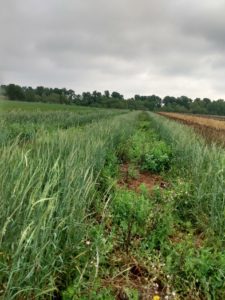Jake Mowrer, PhD
Cover cropping has many benefits in dryland farming in eastern and central Texas. Weed suppression, crop diversity, soil organic matter buildup, and more. Many Texas farmers have an interest in getting into or improving their cover crop inclusive systems. But cover cropping is not a simple thing. It takes some time and patience to get it right here. AgriLife Extension recommends that farmers start experimenting on a small portion of the farm, and expand to more acreage as specific practices show success.
This article covers one critical aspect of cover cropping. Timing.
Now is the time to be planning for fall cover crop planting. Many farmers have harvested their corn. Others are close. And the sorghum season is winding down as well. AgriLife Extension recommends planting most cover crops in early October. The planting window extends to mid-November, but expect lower productivity by spring termination for each week you push the timing back.
This means that August is the time to be sourcing and purchasing seed and ensuring that all other pieces are in place. You want the seed in hand, and you don’t want any surprises (other than weather) to cause delays in planting.
Delays in fall planting are the most important factor leading to cover crop underperformance.
When planning for cover crop species, there are several factors you need to consider carefully. Timing of your spring cash crop establishment is one of the most important. If you are planting corn, which has the earliest planting time, you need to choose something that matures quickly in late winter/ early spring. AgriLife has seen the best early maturing success with legumes such as winter pea and hairy vetch. Avoid legumes such as common vetch, crimson clover, or berseem clover when corn is to be planted. Other rapidly developing cover crop choices include cereal rye (Maton or Elbon), oats (Heavy Grazer), and mustard (White Gold matures earlier than Kodiak).
For later planted crops such as sorghum or cotton, crimson clover and Kodiak mustard will catch up with the biomass production of the other varieties mentioned. Cereal rye, oats, hairy vetch, and winter peas will continue to put on biomass as the days grow warmer. Common vetch and berseem clover have not been high performing cover crops in eastern and central Texas, regardless of timing.
The timing of cover crop termination in Texas is key success, also. This is especially true in minimal till systems. Research at Texas A&M AgriLife farms shows that there is a fine line between termination planting windows where the soil remains wet and cover may be too thick to plant through (1-2 weeks), and leaving too much time so that the residue breaks down so much that weeds begin to be a problem (4-5 weeks). Rolling and crimping termination is an excellent way to provide weed suppression and conserve soil moisture in spring. Strip tilling or drilling cash crop seed directly into residue when decomposition has progressed to ‘flatten the mat’ are good ways to manage establishment.
When rolling and crimping, understand that green stems will likely continue to grow and rise again unless an herbicide kill is applied behind the operation. Drier brown stems on your cover crop will snap under the crimper more completely, preventing regrowth. Cover crops can also be terminated by mowing or straight herbicide application. Mowing leaves residue vulnerable to transport off site by wind and rain. Herbicide is a complete way to kill a cover crop, but does often leave the plants standing for some time, providing less weed control than a mat would. When plowing in residue to incorporate, transport losses are minimized, breakdown is more rapid, and weed suppression is lost.
It is important to consider ahead of time your complete plan of action for cover cropping. But right now is the time to be sourcing and purchasing seed.
Image 1. White gold mustard (foreground) freshly rolled and crimped. Kodiak mustard in the background. Approximate height of each crop = 5 – 6 feet. Picture taken March 27th near College Station, TX. White gold could have potentially been terminated two weeks earlier with similar biomass, but Kodiak was just reaching its full potential in late March.
- Berseem clover (extreme right foreground) and Crimson clover (middle right), cereal rye (right, and winter pea (far right middle) relative biomass first week of February near College Station, TX.
Image 3. Common Vetch (near middle) plots provided little biomass even by the first week of April. This allowed for weed emergence. In comparison, cereal rye (right and left) provided good biomass and weed control by this time.
Image 4. Winter pea (middle) by the first week of April has good biomass and weed control. However, cereal rye (right and left) continue to outstrip all legumes in terms of biomass and weed control in this study.
Image 5. Winter pea in bloom. April 9, 2020
Image 6. Crimson Clover in bloom. April 9, 2020





